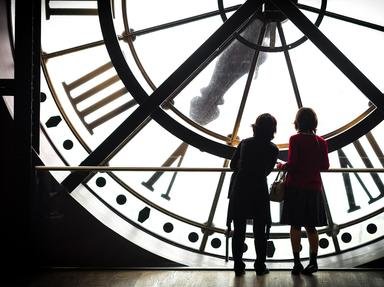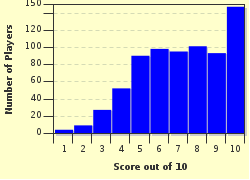Quiz Answer Key and Fun Facts
1. Our ancient ancestors had a very vague grasp of time as we know it today. "Meet me at the buffalo watering hole when the sun is highest" would be a common way to set up an appointment. "When the sun is highest" means that there is the least amount of shadow. What is it called, however, when the sun is perfectly 90 degrees overhead, and there are no shadows cast by vertical objects?
2. A good way of measuring time is waiting for a bin to fill up. An example of this is the hourglass, which waits for sand to fill up in a glass "bin". Another example is the clepsydra. What did it use as its "bin filler"?
3. All this talk of telling time made me glance up at the wall to check my clock. The word 'clock' has Latin origins. What does it mean?
4. A pendulum clock uses the fact that no matter how large the arc of the pendulum, it will always complete one sweep back and forth in the same amount of time. Which Italian was responsible for this discovery?
5. The Romans divided the year into twelve months, and the calendar we use today is based on it. However, there are some calendars whose months are based on the revolution of the Moon around the Earth. Which is not one of them?
6. With the decimal system, everything is divided into tens. However, minutes are 1/60 of an hour, and seconds are 1/60 of a minute. To which ancient civilization do we owe this division?
7. It is not well known that Frenchman Louis Cartier designed the first wristwatch in 1904. However, wristwatches only became more popular than pocketwatches after World War I.
8. Many modern timepieces use a certain crystal which, when shaped correctly, emits a frequency that can be accurately calculated. This creates a very accurate timepiece. Which crystal is used?
9. Similar to the title of the quiz, in 1988 British physicist Stephen Hawking Published "A Brief History of Time". In it, he tries to explain to you and me that time is not an absolute measurement. Which, according to special relativity, is the only fundamental unit in the universe?
10. A second had to be standardized so that physicists around the world would have the same unit when measuring it. It's not enough to be 1/60 of a minute or 1/3600 of an hour, or even 1/86400 of a day. A second is now measured by the spins of which of the following atoms?
Source: Author
LeoDaVinci
This quiz was reviewed by FunTrivia editor
crisw before going online.
Any errors found in FunTrivia content are routinely corrected through our feedback system.

